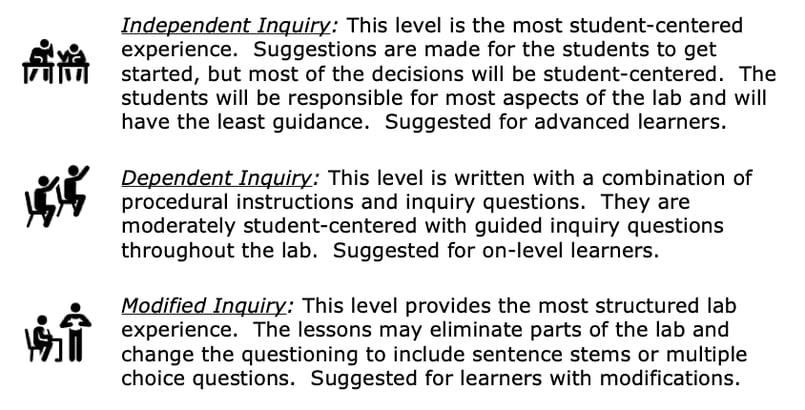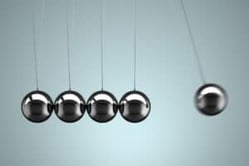Kinetic Energy Inquiry Lab
Middle School Inquiry Lab on Kinetic Energy
In this lab students will compare what happens when one object strikes another. Students will be challenged to try to increase the amount of energy transferred between the two objects.
Each inquiry lab will contain an essential question that will drive the lesson and make students think. For this lesson, the essential question is:
- How do we know that kinetic energy can be transferred from one object to another?
BACKGROUND INFORMATION AND MATERIALS LIST:
Students will begin the lab by reading the essential question and background information. This can be done individually, as lab groups, or as a whole class. If you consider lab groups, you also might include some type of whole class formative checks before digging into the lab.

Materials List:
- insulation tubing cut in half
- skewers (to create stability)
- tape
- books (to create height)
- yardstick
- 2 large marbles
PROCEDURE:
This lab is best done on a flat floor, such as a gym or hallway. First thing students need to do is to stick the skewers through the tubing and tape one end to the floor. Using books or other materials to create specific heights, students will tape the other skewered end to the books. Now that the ramp is set, students will place one marble at the end of the tube ramp while placing another at the beginning. Letting the top marble roll, students will measure the distance the bottom marble travels after the top marble strikes it.
The students will do this for three trials before altering the height of the ramp. Once the students have measured distances traveled for all six total trials, students will take this data and create a line graph.
CHECK FOR UNDERSTANDING:
At this point in the lab, students will be checked for understanding by answering questions about their findings. Here are a few that come with the lab:
- What kind of energy did the marble have at the top of the tube?
- What kind of energy did the first marble have when it started rolling?
- Where did the lower marble get its energy?
- How did the energy of the top marble change when the height of the books increased?
- How did the lower marble respond to the change in the energy of the upper marble?
CONCLUSION
Students will go back to the essential question and write a CER (Claim, Evidence, Reasoning) to conclude the lab. Once completed, students will reflect back on their learning by answering the following questions:
- Name the variables (conditions that were changed) in the experiment.
- What can you conclude about the relationship between height and kinetic energy?
MODIFIED AND INDEPENDENT INQUIRY VERSIONS
All of the Kesler Science inquiry labs come with three different modification levels. Each lab is differentiated using the icons below.
STANDARDS ALIGNMENT
NGSS: MS-PS3-5 – Construct, use, and present arguments to support the claim that when kinetic energy of an object changes, energy is transferred to or from the object.

Download Over $100 in FREE Resources
For Middle School Science
Simply create a login below and gain immediate access to a selection of our Kesler Science product line worth $100 - for FREE. There's a full version of every product type! You'll also join tens of thousands of middle school science teachers who receive timely tips and strategies straight to their inbox.





